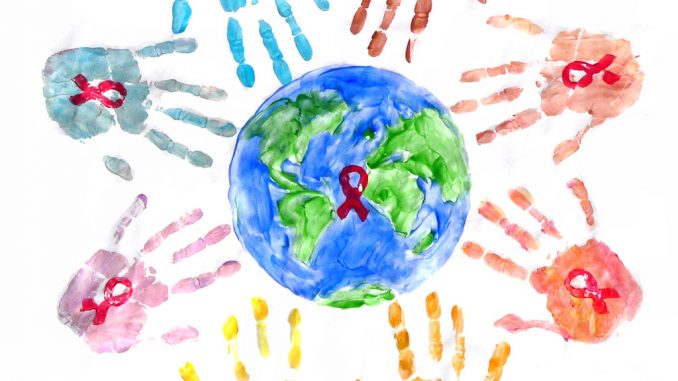
Gary Levinson was a senior at SUNY New Paltz when he learned about HIV for the first time. But he was still unaware that he had been living with HIV for four years at that point. He hadn’t experienced any symptoms.
It was 1989. Before the ‘80s, scientists and doctors still did not fully know what HIV was. What they knew was that there were clusters of people dying in places like downtown Manhattan, Ulster County and Southern California.
Misconceptions about HIV were rampant.
In the early ‘80s, some referred to it as GRID, or Gay Related Immune Deficiency. Some called it “gay cancer.” These ignorant names were used because some of the first cases discovered were found in gay men. Later, people thought the only people prone to HIV were those in “the 4H Club”: homosexuals, hemophiliacs, Haitians and heroin users.
This idea was far from the truth, but extremely common, just as many misconceptions about HIV are.
When Levinson began getting sick, four years after he had unknowingly contracted HIV, his doctor misdiagnosed him with pneumonia. But of course, his body did not respond to medicine for pneumonia. He continued to experience a worsening level of difficulty breathing, excessive sweat through the night and lost 25 pounds in two weeks.
Levinson’s dad drove from New York to Tennessee in 12 hours to be with him. On Nov. 14 at around 4:30 p.m., the doctor walked into his room, closed the door and told him three words that changed his life forever: “You’ve got AIDS.”
He and his father began to cry. “Everything I had learned about HIV and AIDS was: if I got it, it was going to kill me,” Levinson said. His father gave him a hug as they cried together and a few moments later, Levinson’s father nervously looked up at the doctor and asked if it was safe for him to hug his son.
Hugging is not a way of transmitting HIV.
According to the Center for Disease Control and Prevention (CDC), there are three main ways of contracting HIV. The first is through sharing needles, which, contrary to popular belief, is not limited to heroin needles. People have contracted HIV by sharing insulin needles, piercing needles and recycled ink from tattoos.
Because the first test to detect HIV antibodies in blood was developed in 1985, many hemophiliacs who got blood before then were infected with HIV.
The second is from mother to child, which can occur during childbirth, pregnancy or breastfeeding. Thanks to today’s availability of antiretroviral therapy (ART), mothers who use ART have a fewer than 1% chance of transmitting HIV, according to HIV.gov.
The final way is through sexual contact, which includes anal, vaginal, oral and “digital” sex (also known as fingering). Anal and vaginal unprotected sex are the most likely ways of transmitting the disease sexually.
In 2016, 1.1 million Americans had HIV, but one in seven did not know it, according to the CDC. Levinson’s story illustrates why this could be so dangerous.
Six years ago, Levinson was contacted by his stepdaughter. She shared that in 2007, her mother, Levinson’s ex-wife, had been diagnosed with AIDS.
Levinson had transmitted HIV to her while not realizing he was infected. Her HIV quickly progressed to AIDS, a disease she passed away from on Aug. 31, 2008.
“To this day, that’s still the hardest thing I have to deal with…I unknowingly gave her HIV and it took her life,” Levinson reflects.
Levinson remembers hearing a coworker at work say years ago, “I hope that they don’t find a cure for AIDS. Get rid of all those undesirable people.”
“The problem is in this country it was first seen in certain populations and because of that there was labels and stigmas associated with it,” Levinson explained to the audience. “The only requirement of getting HIV: you have to be human. Everybody in this room qualifies.”
The cure for HIV has yet to be discovered, though there are many medications used with adverse side effects and plentiful issues. When Levinson was diagnosed, his doctor predicted he would live for 12-18 months. 27 years later, he is still here, but survival has not been easy.
At his worst, Levinson had to take 48 pills a day. One side effect for one medication included passing a kidney stone every week and a half (another medicine was prescribed to ease pain while passing kidney stones). Most HIV medicines are precursors to developing diabetes. Currently, his medication costs a total of $84,000 per year.
Dating with HIV is also difficult, scary and lonely. Two people with HIV still run the risk of infecting each other with new forms of the virus which could worsen each of their current conditions. Levinson describes how his HIV status complicates any relationship.
“Since my diagnosis, I’ve traveled to 49 of the 50 states, I’ve been through almost every province in Canada, I’ve been to Mexico, Central America, South America, the Caribbean,” he said. “I’ve gone zip lining from the top of the mountain down through the rain forest to a beach…I live life to the fullest. I have to. I don’t know what tomorrow will bring.”

